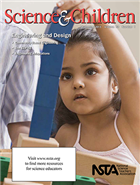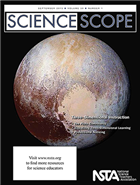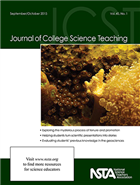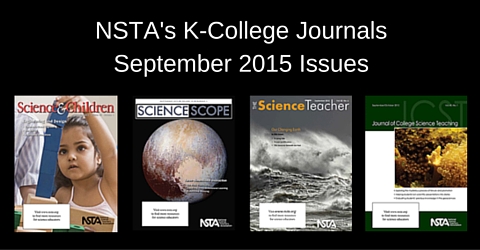NSTA’s K-College September 2015 Science Education Journals Online
By Korei Martin
Posted on 2015-09-07
Wondering how to introduce your students to engineering? Want an in-depth look at Pluto? Want to know when the “Great Acceleration” began and why it’s named that? The September K–College journals from the National Science Teachers Association (NSTA) have the answers you need. Written by science teachers for science teachers, these peer-reviewed journals are targeted to your teaching level and are packed with lesson plans, expert advice, and ideas for using whatever time/space you have available. Browse the September issues; they are online (see below), in members’ mailboxes, and ready to inspire teachers!
 Science and Children
Science and Children
The Next Generation Science Standards (NGSS) is leading the call for more emphasis on engineering in our schools. This issue of S&C includes strategies, ideas, and techniques to help you bring engineering and the design process into your classroom.
Featured articles (please note, only those marked “free” are available to nonmembers without a fee):
- Free – Answers to Teachers’ Questions About the Next Generation Science Standards
- Community-Based Engineering
- Designing a Sound-Reducing Wall
- Free – Editor’s Note: STEM
- Gimme an “E”!
- Free – Scampering Into Engineering!
- The EDP-5E
- Full Table of Contents
 Science Scope
Science Scope
The New Horizons space mission provided us with a spectacular, in-depth look at Pluto as it hurtled by the dwarf planet in July of this year. In this issue, we explain how to take an in-depth look at a variety of science concepts by incorporating the three dimensions of the Next Generation Science Standards into your lesson plans.
Featured articles (please note, only those marked “free” are available to nonmembers without a fee):
- Free – Answers to Teachers’ Questions About the Next Generation Science Standards
- Botanical Heart Throbs: Heart Rate in Blackworms
- Free – Editor’s Roundtable: Three-Dimensional Teaching
- Exploring the Science of Less-Familiar Forms of Animal “Flight”
- Free – The Controversy Over Pluto: Planet or Astronomic Oddball?
- Using Professional Noticing to Address Middle Level Students’ Alternative Conceptions of Lunar Phases
- Full Table of Contents
 The Science Teacher
The Science Teacher
Change has always been a constant on planet Earth, yet change today seems different both in pace (fast) and source (us). The middle of the 20th century began what has been dubbed a “Great Acceleration,” a rapid and profound transformation of humanity’s relationship with the natural world, a relationship addressed in several feature articles in this issue. This accelerated change has led scientists to consider whether to christen a new geological epoch, the Anthropocene, to recognize the human species as a biogeophysical force capable of leaving a durable imprint on the geological record. The Earth’s intricate interrelated systems deserve our mindful attention and protection. If this is truly the age of the Anthropocene, will we be up to the task?
Featured articles (please note, only those marked “free” are available to nonmembers without a fee):
- Free – A Rising Tide
- Free – Answers to Teachers’ Questions About the Next Generation Science Standards
- Free – Editor’s Corner: Our Changing Earth
- Ocean Acidification
- Teaching Science Through Inquiry
- The E-mail Lab
- The Resource Beneath Our Feet
- Full Table of Contents
 Journal of College Science Teacher
Journal of College Science Teacher
Learn how one author increased student confidence in giving scientific presentations by showing them how to present findings as a narrative story or personal anecdote. Don’t miss the study that assessed the effect of a problem-based learning teaching strategy on student academic achievement in an undergraduate Biomechanics course. Also, read how participation in Saturday Science—a weekend science enrichment program where local families are invited to participate in hands-on science activities—led to increased confidence for student teachers in various aspects of science teaching and learning.
Featured articles (please note, only those marked “free” are available to nonmembers with
out a fee):
- Free – Editorial: Heavy in August
- Geographic Affiliation and Sense of Place: Influences on Incoming Online Students’ Geological and Meteorological Content Knowledge
- Free – Getting the Most Out of Dual-Listed Courses: Involving Undergraduate Students in Discussion Through Active Learning Techniques
- Interactive Taste Tests Enhance Student Learning
- Research and Teaching: Assessing the Effect of Problem-Based Learning on Undergraduate Student Learning in Biomechanics
- Research and Teaching: Data Visualization Literacy: Investigating Data Interpretation Along the Novice–Expert Continuum
- Research and Teaching: Investigating Preservice Teachers’ Self-Efficacy Through Saturday Science
- Turning Scientific Presentations Into Stories
- Using Reading Quizzes in STEM Classes—The What, Why, and How
- Full Table of Contents
Get these journals in your mailbox as well as your inbox—become an NSTA member!
The mission of NSTA is to promote excellence and innovation in science teaching and learning for all.
Follow NSTA
Disclaimer: The views expressed in this blog post are those of the author(s) and do not necessarily reflect the official position of the National Science Teaching Association (NSTA).


